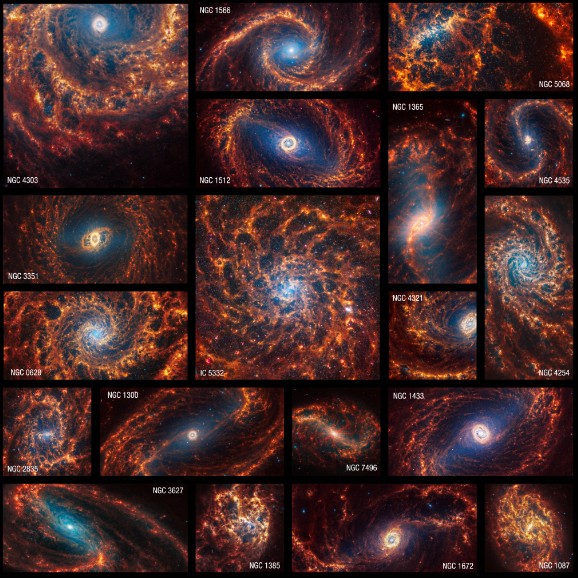NASA's James Webb Space Telescope has unveiled a stunning cosmic web, showcasing images that reveal never-before-seen details of some nearby spiral galaxies.
The telescope's images are part of the Physics at High Angular resolution in Nearby GalaxieS (PHANGS) program, a collaborative effort involving over 150 astronomers globally.

NASA's James Webb Space Telescope Delivers Detailed Scenes of Nearby Galaxies
Before Webb's contribution, the PHANGS program had accumulated data from various instruments, including NASA's Hubble Space Telescope and the Very Large Telescope's Multi-Unit Spectroscopic Explorer.
However, Webb's near- and mid-infrared capabilities have added valuable new insights to the existing dataset. Janice Lee, a project scientist at the Space Telescope Science Institute, expressed awe at Webb's images, describing them as extraordinary and mind-blowing.
The images, captured by Webb's Near-Infrared Camera (NIRCam), showcase millions of stars in blue tones, some scattered across spiral arms and others clustered in star formations.
"They're mind-blowing even for researchers who have studied these same galaxies for decades. Bubbles and filaments are resolved down to the smallest scales ever observed, and tell a story about the star formation cycle," Lee said in an official statement.
The Mid-Infrared Instrument (MIRI) on Webb reveals glowing dust, providing insights into its distribution around and between stars. MIRI also highlights nascent stars still enveloped in gas and dust, resembling bright red seeds at the tips of dusty peaks.
One remarkable feature observed in the images is large, spherical shells in the gas and dust, believed to be created by the explosions of one or more stars. According to Adam Leroy, a professor of astronomy at Ohio State University, these shells represent holes carved out in the interstellar material.
Following the spiral arms reveals extended regions of gas appearing in red and orange hues. These structures, likened to waves, offer valuable information about how galaxies distribute their gas and dust, shedding light on star formation processes.
Read Also : NASA's James Webb Space Telescope Captures Amazing Star Birth Cluster in Neighboring Galaxy
Distribution of Stars
The images also provide insights into the age distribution of stars within galaxies. Evidence suggests that galaxies grow from their cores, with star formation initiating at the center and spiraling outward along the arms.
According to NASA, older stars are concentrated near the cores, while younger stars are found farther away. NASA further noted that pink-and-red diffraction spikes in galaxy cores indicate potential active supermassive black holes or exceptionally bright star clusters saturating the image.
Eva Schinnerer, a staff scientist at the Max Planck Institute for Astronomy, explained that such spikes are clear signs of intense brightness in the central region.
Webb's contribution has not only enriched the scientific understanding of these galaxies but has also resulted in the most extensive catalog to date of approximately 100,000-star clusters released by the PHANGS team.
The wealth of data presented in these images opens avenues for extensive research and analysis, contributing to a more comprehensive understanding of the life cycles of stars. You can view the images of 19 spiral galaxies here.
Related Article : NASA's James Webb Space Telescope Finds Something Weird Inside Mysterious 'Brick' in Milky Way

ⓒ 2025 TECHTIMES.com All rights reserved. Do not reproduce without permission.




